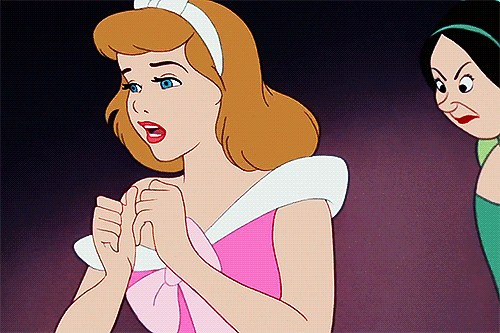Fiction Relationship Analysis: What Our Favorite Stories Are Really Telling Us
This Month: Disney’s Hunchback of Notre Dame
by: Melissa Koons
www.melsmagnificentmusings.com
Copyright all imagery used in this post belongs exclusively to Disney and their animated film.
Popular culture has a huge impact on our social and psychological development. We shape many of our beliefs and perspectives about ourselves based on popular culture and our reaction to it. This can have both positive and negative effects on our development and personal identity. Sometimes, we become stronger because we were inspired by our favorite superhero to stand up for what is right and be allies for those who cannot advocate for themselves. Sometimes, we feel weakened because our lives aren’t falling into the normal storytelling arc and we wonder what is wrong with us. (Hint: life doesn’t have a formula like a good story. It’s not you, it’s your conditioning.)
While popular culture can shape many and all aspects of our perception— from our body image, to our character, to our passions, to our choice for a career— one of the most significant (and problematic) aspects it shapes is our perception of relationships.
Within literature, film, video games, graphic novels, and all other manners of storytelling, we are exposed to thousands of very toxic relationships. Toxic workplace dynamics, toxic friendships, toxic family relations, and toxic romances. While not all stories romanticize these toxic relationships, our perception and interpretation can. When we see these characters get a resolution (happily ever after or otherwise) we can use that to reason or excuse similar toxic behavior in our own lives. Instead of recognizing the resolution for what it is and what it is meant to be, we make it into more or are disappointed when it isn’t.
This month’s Fiction Relationship Analysis is going to focus on Disney’s Hunchback of Notre Dame. This story has a lot of conflicted feelings about it and some people love it, hate it, or have very mixed feelings about how all the characters are left at the end of the story.
Warning: there be spoilers ahead!
Disney’s Hunchback of Notre Dame is a loving adaptation of the Victor Hugo classic. The ending was greatly changed from Hugo’s original novel, and I think we are all better for it. While French Gothic Literature has a special place in history and there is a certain literary genius to it, it is super depressing. Yes, the original ending is beautiful in its tragedy, but Disney’s is beautiful in its re-imagining and actually has a better message about relationships.
Quick Summary
Set in Paris, France 1482, Frollo is a self-righteous judge who is focused on cleansing the city of gypsies and other ethnic minorities. The movie starts with Judge Claude Frollo setting a trap for a group of gypsies trying to escape the city. As their ship is stopped by law enforcement and the occupants are dragged out and shackled to be imprisoned, one woman escapes with a bundle which the audience knows to be her infant child. Frollo and his men pursue under the belief that she is fleeing with stolen goods (which emphasizes Frollo’s racism and prejudice against this group of people that he doesn’t even consider for a moment that she may be holding her own belongings or child.)
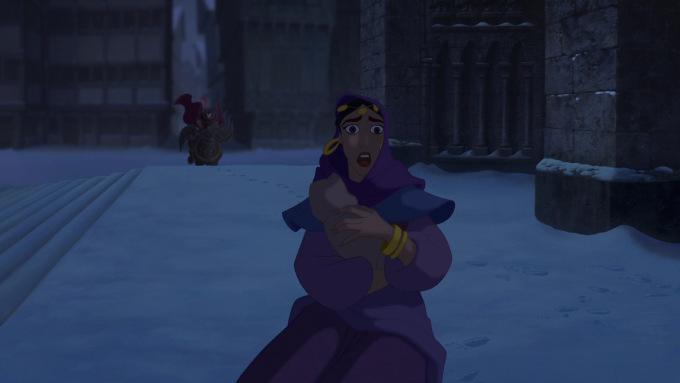
The woman runs to the steps of Notre Dame—one of the largest cathedrals in the center of Paris—and begs for sanctuary. Before the priest can let her in and grant her safety (per the rules of the church and pope. All within its walls are protected by God and cannot be persecuted provided they offer penance. This plays a big role in the movie,) Frollo grabs her baby from her and kicks her down the steps, killing her. When he discovers the bundle is a baby, who suffers from a deformity, he goes to drown the child but the priest stops him. In a moment of guilt, the priest convinces Frollo to spare the child and care for him. Frollo agrees, provided the child can live, locked away, in the bell tower. He names the child Quasimodo, and that is the hunchback’s tragic origin story.

After about 18 years of being trapped in the bell tower ringing the bells for mass, Quasimodo gets an itch to go out into the city and live his life. Frollo doesn’t allow it, so he chooses to escape without Frollo’s permission to attend the Festival of Fools. Everyone is dressed in crazy clothes and masks, so he blends right in.
While Quasimodo is plotting his escape, we are introduced to Phoebus, Frollo’s new captain. Phoebus walks through the streets and we witness the discrimination Frollo shows gypsies in Paris when Phoebus sees Frollo’s militia chase the gypsy Esmeralda and try to confiscate the money she earned as a street performer under the assumption that she stole it (seeing a pattern? Sounds like the same prejudice that got Quasimodo’s mother killed. That’s not by accident.) She escapes, but loses some of her hard earned money. Phoebus, in an act that shows his disagreement for Frollo’s method and racism, returns the money to her.
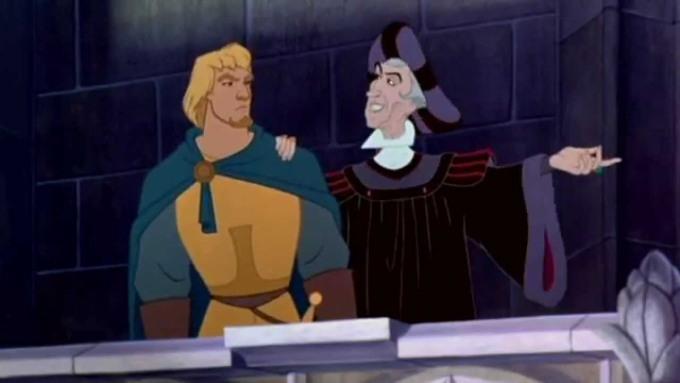
Phoebus is eventually brought to Judge Claude Frollo, where he learns of the evil judge’s plan to wipe the gypsies out with an act of genocide (let’s not sugar coat it, that’s totally what he’s doing. Disney went there.) Phoebus disagrees, but as a man of honor and military training, he also knows he has to follow orders lest he be dishonorably discharged and hanged for treason. (Frollo’s threat of torture doesn’t help.) Phoebus isn’t looking at very great options right now. Be party to genocide, or be hanged for doing the right thing. Quite the moral dilemma, but I digress.
Seriously, look how creepy Frollo is when threatening his new Captain with torture. Phoebus is understandably apprehensive, Frollo is seriously disturbed.
Quasimodo makes it down to the street festival and he’s having a grand ol’ time. He’s very self-conscious, but no one seems to notice because they believe he is wearing a mask like they are. This is where he meets Esmeralda and is shown the first kindness and compassion from another person he’s ever received in his life (except the priest.) It is important to note, that his brief conversation with Esmeralda before the street show starts is probably his first interaction with a woman, ever. After some good fun and a quirky musical number, he is discovered as the bell ringer and Frollo enacts a public punishment for Quasimodo disobeying him by turning the crowd against him and allowing them to humiliate him. Esmeralda is the only one to step up and stop the bullying, untying him and making a public statement about how her people are treated similarly inhuman by Frollo and his militia.

Phoebus stands at Frollo’s left hand. He suggests calling the cruelty of the crowd off before Esmeralda steps up, but is denied by Frollo and he has to follow his orders. This, again, shows his compassion and disagreement for Frollo’s methods. After Esmeralda rescues Quasimodo, Phoebus is given the command to arrest her. Phoebus chases her to Notre Dame and they have a squabble.
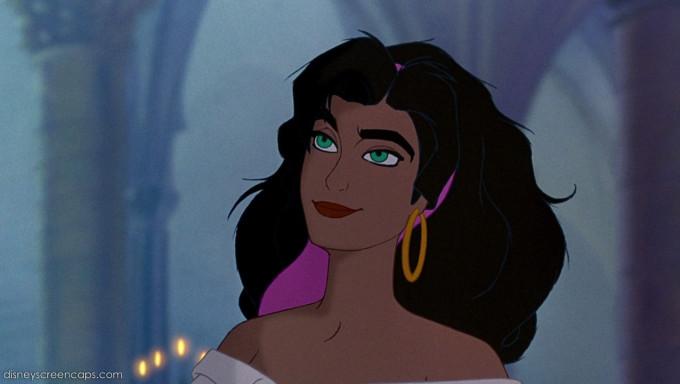
Esmeralda is defensive, but Phoebus proves that he is really on her side although he is limited in what he can do for her. When the rest of the militia and Frollo catch up, Phoebus lies and tells them that Esmeralda claimed sanctuary so they cannot touch her for she is under the protection of the church (see, I told you it was important.) He saved her life to the best of his ability because he knew she was innocent. Frollo and his men are forced to leave, but they stand post outside the cathedral so that, should she leave, they can arrest her once she no longer is protected by the church.
Quasimodo finds Esmeralda in the church (she is kind of stuck there,) and they have a nice chat—the first human chat he’s ever had with another person. She shows him kindness, acceptance, and compassion—all things he’s never gotten from Frollo. Smitten, Quasimodo helps her escape and avoid capture.
Meanwhile, Frollo is wrestling with his own inner demons. He, too, is smitten with Esmeralda. He is drawn to her beauty and it is horrifying for him. Not only because he took a vow of celibacy, but because he is a racist jerk who thinks that her ethnic group is sub-human. He is struggling with his own emotions because he’s dealing with sexual attraction and that attraction is toward a person of color whom he has every intention of wiping out with that whole genocide plan. His solution? He will give her the option to become his mistress or he will burn her. Sex slave or death; not a great ultimatum to be faced with.

Dude is seriously not handling his obsession well.
Frollo discovers that Quasimodo helped Esmeralda escape and is furious. He commands his men to scour the city looking for her and arrest all people he considers to be gypsies or sympathizers. Phoebus follows orders, to a point. Frollo is having his men burn the city down (literally) in his search, but when he traps an innocent family with children inside their burning house because he believes they are withholding information, Phoebus loses it and breaks rank. He saves the people and is marked a traitor for it. Frollo orders his death but Phoebus manages to escape and is saved by Esmeralda. She brings him to Quasimodo for help and safe keeping. Quasimodo is heartbroken because he sees Esmeralda and Phoebus kiss, solidifying that his love is unrequited. After she leaves, Quasimodo is angry with Phoebus but they still form an alliance to help save Esmeralda and her people from Frollo’s genocidal ways.

Frollo tracks Quasimodo and uses him to locate the gypsies’ hideout and arrest all of them. He gives his awful ultimatum to Esmeralda and she chooses the pyre. Quasimodo is chained in the bell tower, and Phoebus is going to be killed with the other gypsy prisoners, leaving them all divided and rather helpless. Through motivation (no longer driven purely by the prospect that Esmeralda may love him in return but now that she is someone he cares about and he can’t let his friends and all these good, innocent people die,) Quasimodo breaks free and saves her from the fire. He also frees everyone else and there’s an epic battle. Frollo perishes, Esmeralda lives, it’s all great.
The very end shows Esmeralda and Phoebus brought together with Quasimodo’s blessing, and the two of them bring him out of the bell tower where he finally finds acceptance among his community. (The victor Hugo ending had Esmeralda die from smoke inhalation and Quasimodo starve himself to death beside her body. Pretty sure Frollo and the captain character both died, too. It’s French Gothic Literature, so it’s safe to assume everyone died.)
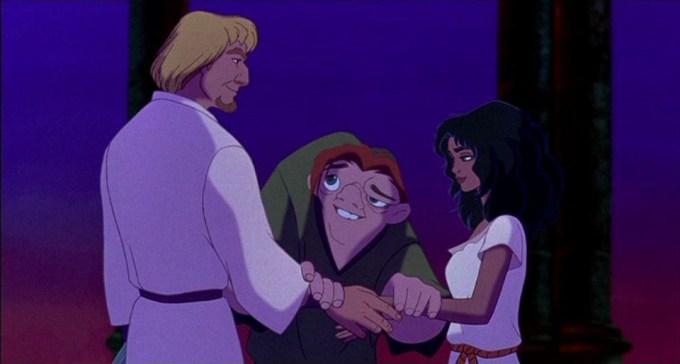
Okay, so that wasn’t such a quick summary but I have reasons for why I focused on all these plot points. Some of the disagreement and mixed feelings with the ending are based on our perception of how these relationships were wrapped up. I don’t think anyone disagrees with Frollo falling to his death into a pit of fire and lava. That was one of the most cathartic villain deaths in a Disney movie. It paralleled his intense faith that he twisted and perverted into the belief that he was superior to others and that certain races and people were sub-human in comparison by literally having him fall from heaven (the bell tower of Notre Dame, one of the most exquisite cathedrals and monuments of the Catholic faith) into the pit of hell (the very fire he had started with his own cruelty and genocide.) An ironic and poetic end for one of the most evil Disney villains. No, what people tend to have a problem with is what happened after Frollo met his demise.
Phoebus is often considered a “bland” character and not whom many viewers wanted Esmeralda to end up with. Some people view that their relationship was forced, or that she should have ended up with Quasimodo. While these perceptions are valid, I’m going to tell you why Disney’s ending was actually the best way to wrap up these relationships.
Esmeralda is unarguably the connective tissue of this entire story. It is her relationships with the three main men that ties them together and moves the plot forward. Through these relationships, we see very different approaches and perceptions of what a romantic relationships are.
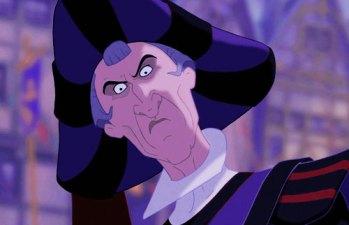
Frollo = Toxic
Frollo’s attachment to Esmeralda is obviously toxic. He is racist and prejudiced against her and her ethnicity, but finds her sexually appealing despite his horrible perception. He objectifies her, mainly because he doesn’t believe her to be human to begin with. To appease his own inner struggle and (horribly misguided) moral dilemma, he reaches the solution that he can still go about his “cleansing” and feel righteous about it provided she chooses to be his mistress. “Be mine and mine alone,” he sings. To him, she is a possession and exists purely for his own satisfaction and desire. She is something to be owned and kept, not a human person with feelings and a life of her own.
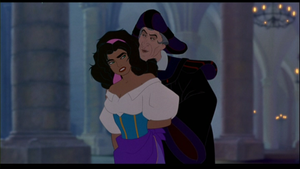
Esmeralda's expressions of disgust in this movie are on point.
He is obsessed with her sexuality and he reasons with himself that it will not be sinful if he makes her “his” because then he will be committing a selfless act of mercy by sparing her and her evilness and making her “good” by affiliating himself with her. It’s all very twisted and toxic. Yikes.
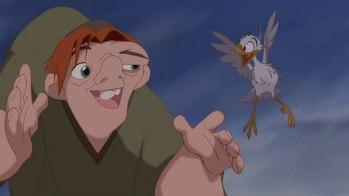
Quasimodo = Toxic
To fill out the dichotomy of the toxic scale, there is Quasimodo’s toxic attachment to Esmeralda. Similar to Frollo, he is obsessed with her. He’s not obsessed with her body or sexuality like Frollo is, instead he is obsessed with her compassion and kindness. She is the first person to treat him humanly, and the first woman. She fills the void of the mother Frollo killed, and gives him the acceptance and compassion Quasimodo has always sought from the world. He loves how she makes him feel, not who she really is as a person. He loves what she gives him, and he takes it greedily making their relationship incredibly imbalanced. He needs her validation and affection, but he isn’t able to return it in a healthy way. He cannot support her emotionally because he relies on her to heal him and fix his wounds. This is incredibly toxic because Esmeralda will forever be in the position of giving and her needs will never be met. More than that, Quasimodo idolizes her. Since she is the first person (and woman) in his life to fill that void, he put her on a pedestal where he worships her. She can do no wrong in his eyes, and that dehumanizes her by making her divine. She is no longer a person with thoughts, feelings, and mistakes.

To his credit: while it hurts him, Quasimodo does accept her choice to be with Phoebus and gives his blessing on the relationship as a friend. He doesn’t hold it against her or hate her because she didn’t choose him (which we often see in the toxic “nice guy” perception.) He befriends Phoebus and learns that he is a good, honorable man and Quasimodo chooses to help him and Esmeralda despite being rejected. He’s also not waiting for her to change her mind. His character develops and he understands that to love someone means loving them and their freedom to make their own choices. So, bright side is that while their relationship started off toxic, it concluded with a healthy balance. Quasimodo accepts her as a friend and from this position he can get his needs met without preventing Esmeralda from getting the same.
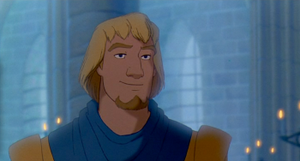
Phoebus = Healthy
For starters, Phoebus isn’t a bland character. He is an honorable, intelligent man who shows compassion towards others—especially toward those who are different than him. He is an ally for all people who face discrimination and he tries his best to use his position of power to help them, but he is limited by his own station and orders. He does not agree with Frollo’s plan to commit genocide, and starts to vocalize it but is shown by Frollo what will happen to him should he step out of bounds (the former captain was tortured for being inefficient and a sympathizer.) Still, facing the threat of death for being marked a traitor, he does what he can to help Esmeralda and others.
While he appreciates Esmeralda's physical beauty, he admires her passion, fire, and strength to stand up to a corrupt system. He loves her for who she is and he doesn’t try to imprison her by objectifying her and making her “his,” nor does he put her on a pedestal where she is forced to constantly be the giver. Instead, he approaches her as an equal. He wants to work with her, not for her or above her. He wants to support her, and in return she offers him support. It is a mutually beneficial relationship where both parties are on the same level and there is no power imbalance. Because of this, both parties can give and receive equally, ensuring that their needs are met.
Phoebus is the only character who perceives Esmeralda as human and treats her thusly. She is not sub-human because of her ethnicity, nor is she divine because of her compassion. He respects her, loves her, and admires her exactly as she is.
Phoebus was the best option for Esmeralda to end up with, and their mutual interests and respect for each other is what gives their relationship a strong foundation. Their relationship was never forced, it just wasn’t dramatic. They started off on opposite sides, but only because of their stations. They always agreed with each other and once they could get past the cultural divide, they were able to fulfill their relationship potential. Their relationship was organic, and had to overcome many obstacles—their love and attraction for each other just wasn’t one of them.

Pop culture has influenced us to believe that a good relationship has to overcome all kinds of dramatic emotional obstacles or differences to work. That’s not true. As evidenced by Phoebus and Esmeralda, the emotional part should come naturally. Yes, they still had obstacles to overcome—both internally and externally—but that didn’t pull them a part. In fact, it brought them closer together because they chose to overcome them together. They had to overcome the distrust that their own experiences have put on them (Esmeralda and law enforcement,) societal and legal expectations (Phoebus following orders,) and cultural/societal discrimination and racism. This was plenty for them to tackle and it didn’t mean that they had to hate each other or need to fight constantly with a whole will they/won’t they tug-of-war.
One of the worst expectations pop culture has given romantic relationships is that every hurdle is ongoing. Many stories circle back to the same conflict again and again in a relationship. The characters can’t let something go, or can’t trust their partner, or whatever else that keeps the same strain on the relationship. This isn’t healthy, and it isn’t good storytelling either. You can actually overcome an obstacle and have it be in the past. And left in the past. Esmeralda overcame her distrust of Phoebus because he proved to her that he respected her and actually agreed with her fight for equality (it wasn’t something he was lying about to get into her pants.) That distrust was never revisited in the story because it was done. They overcame it together and now they had that foundational trust that strengthened their relationship.
Phoebus overcame the societal expectations he had to endure by standing up for what he believed in and confronting an action he knew was wrong. Once he was able to do this, it was never a conflict or struggle they had to overcome again. There was no need. He had support on the other side and didn’t have to tackle this obstacle on his own anymore.
Phoebus and Esmeralda's relationship might seem bland, but that’s because a mutually beneficial, balanced, supportive relationship is. (And I mean that in the best possible way.) They are strong together and they find strength from each other to take on whatever life throws at them. Their relationship doesn’t need to be tumultuous because the world and life is hard enough already. Instead, their relationship is the steady force that keeps them going. WHICH IS WHAT A RELATIONSHIP IS SUPPOSED TO BE.
A relationship isn’t about belonging to someone and finding validation in the fact that they are with you (Frollo.) It isn’t about fixing someone or having someone complete you and fill the void that has been left by your experiences (Quasimodo.) A relationship is about finding someone who respects you and empowers you to be the best version of yourself and gives you the strength and support you need to meet your own goals (Phoebus.)
What the story is NOT telling you: that it's okay to set your needs aside to help someone heal and/or to fill their emotional void nor that it's okay to be objectified by your significant other.
What the story IS telling you: the best partner will be one that sees you as an equal and wants to join you on your life path because you have mutual goals and aspirations. Trust is the foundation in a relationship, as is an equal balance of emotional and physical support.
